
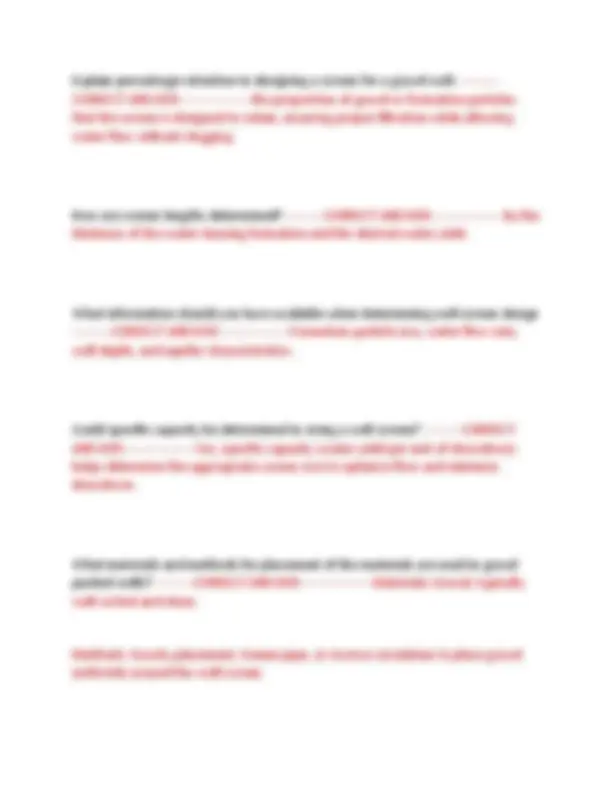
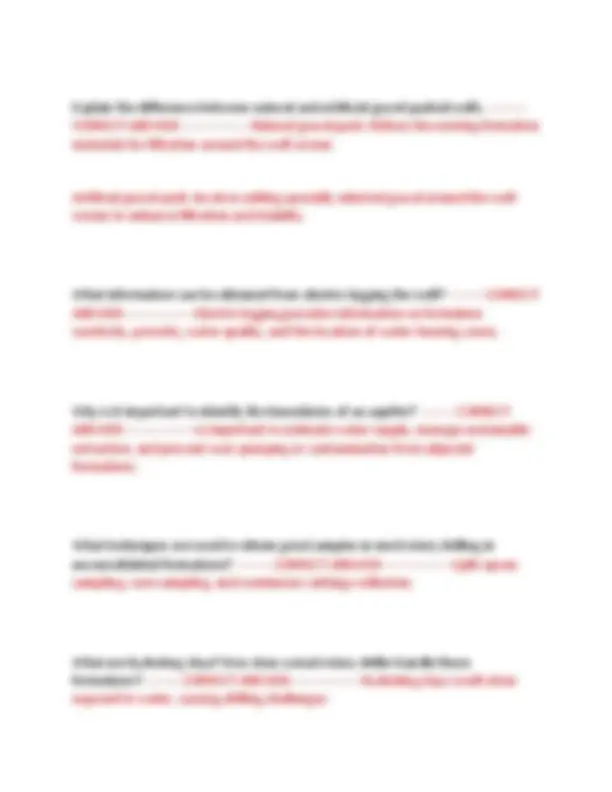
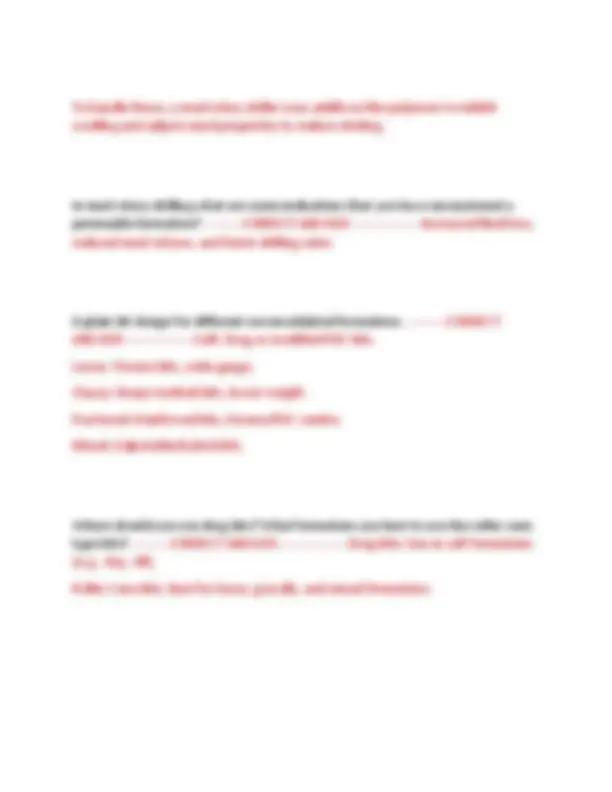
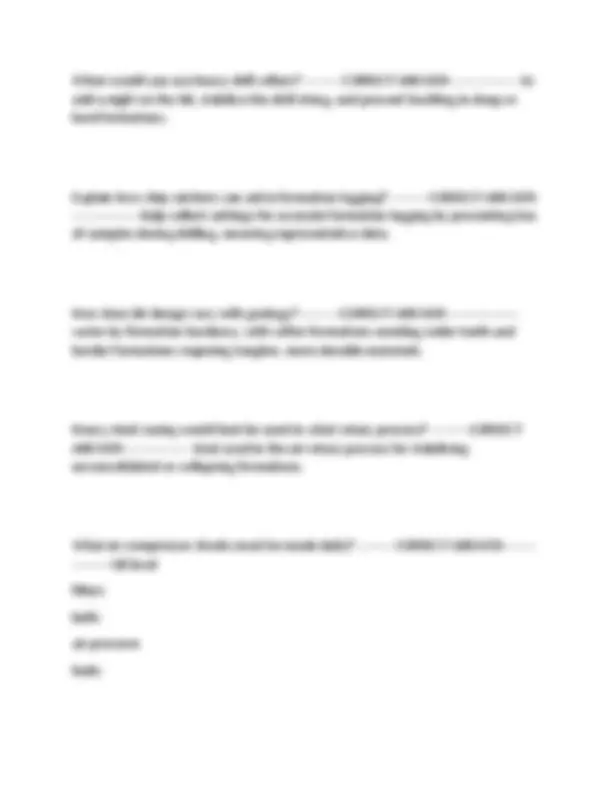
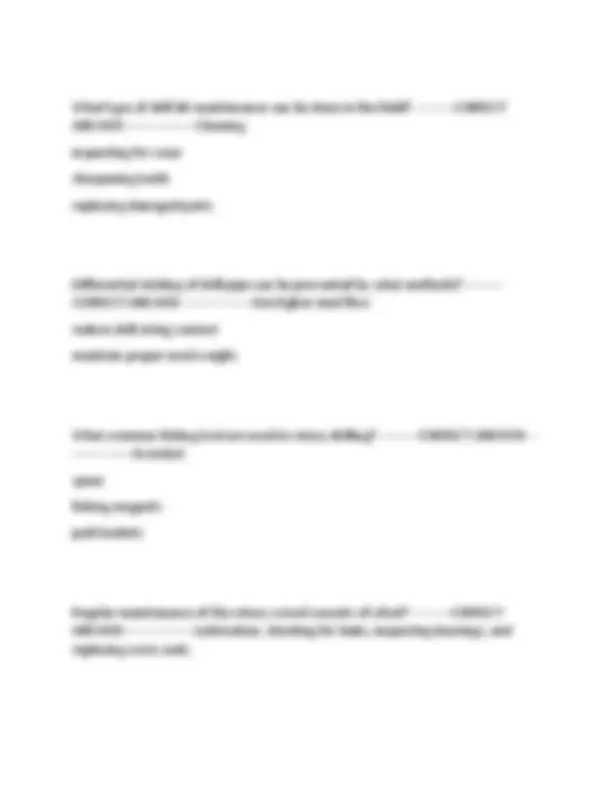

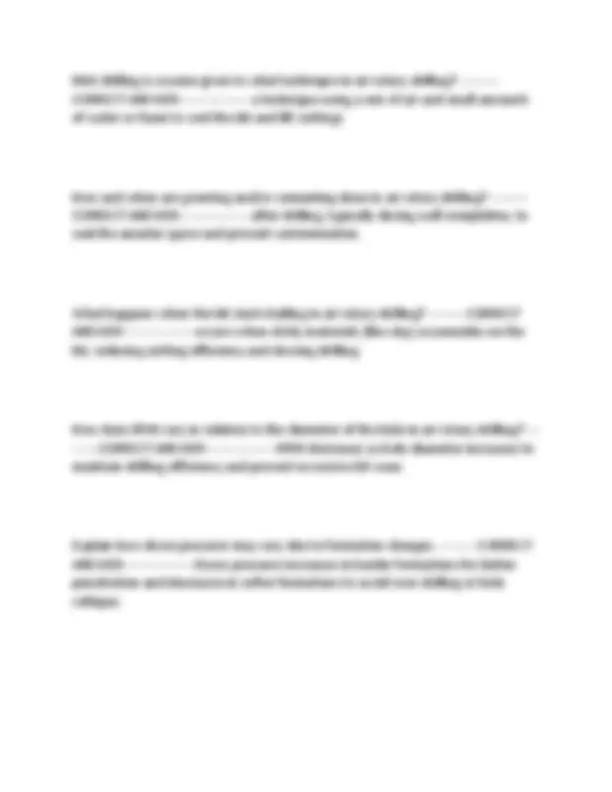
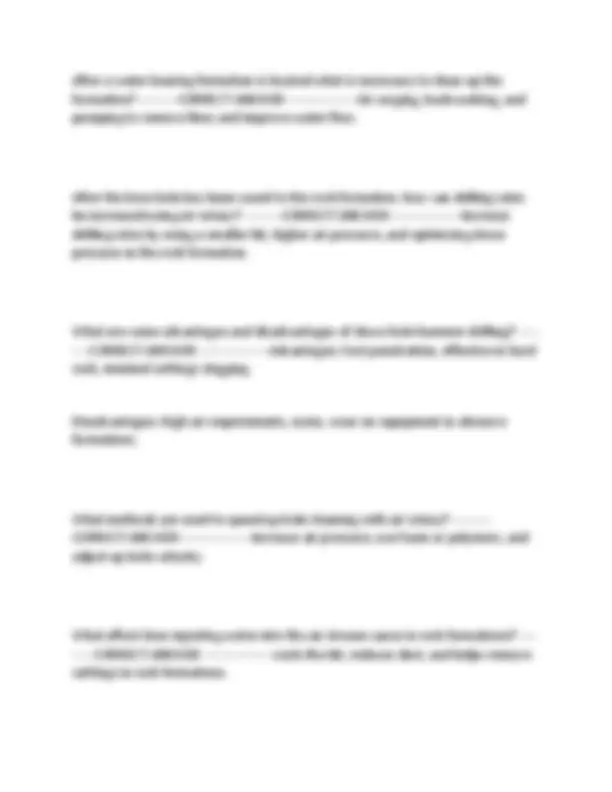
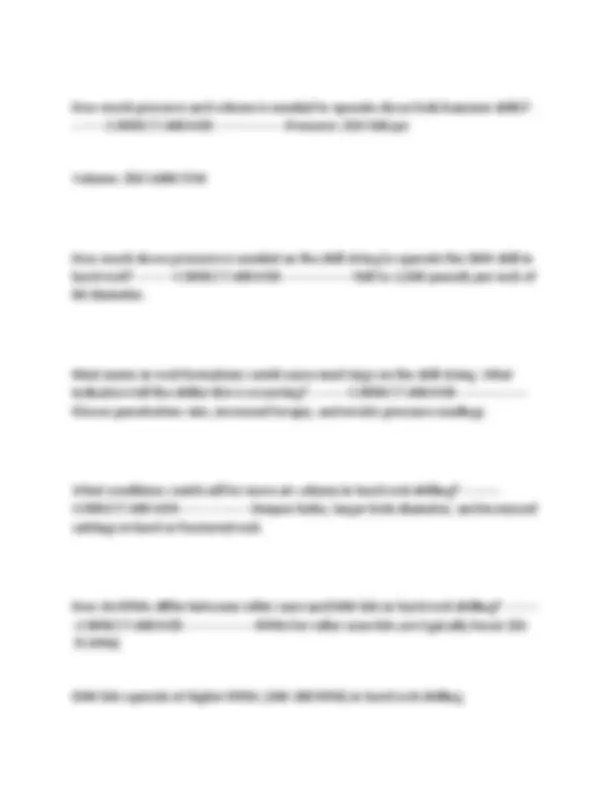
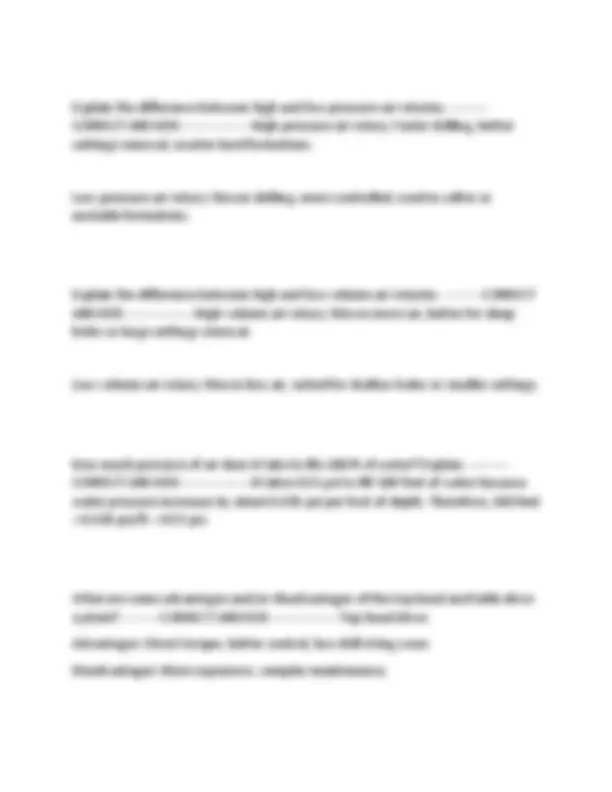
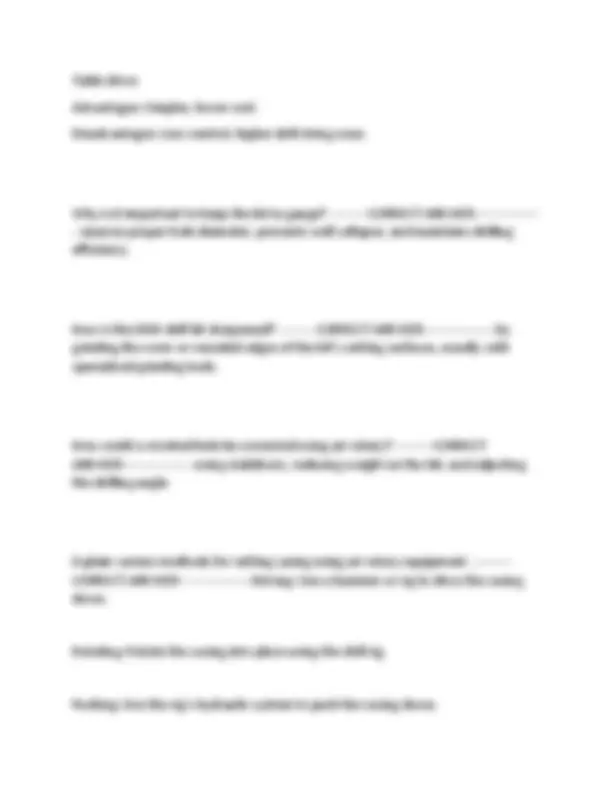
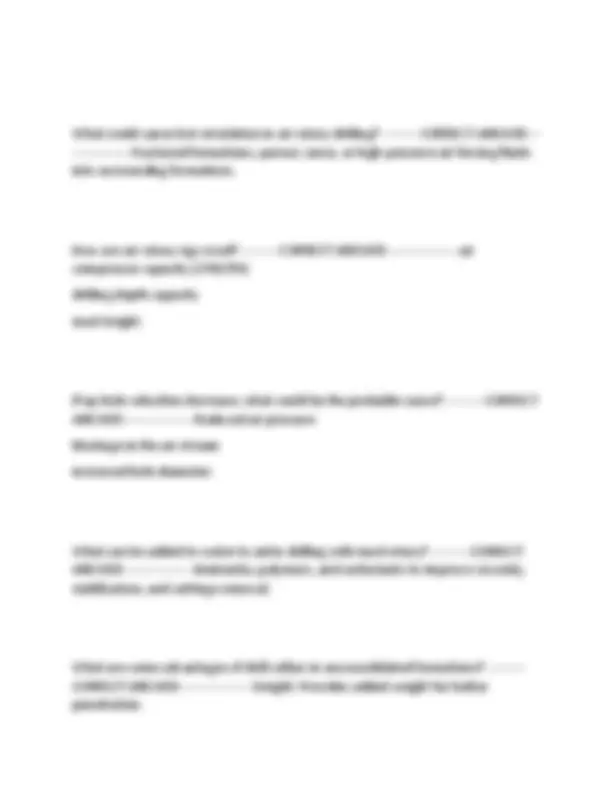
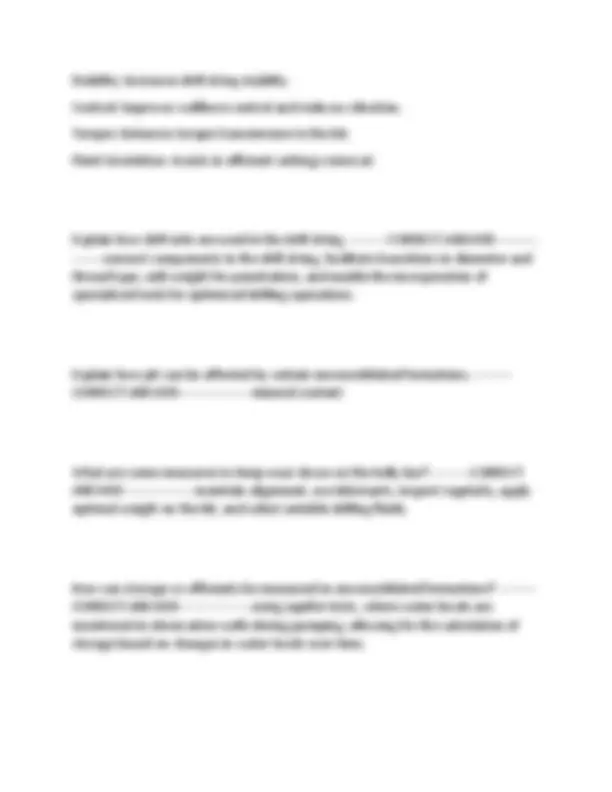
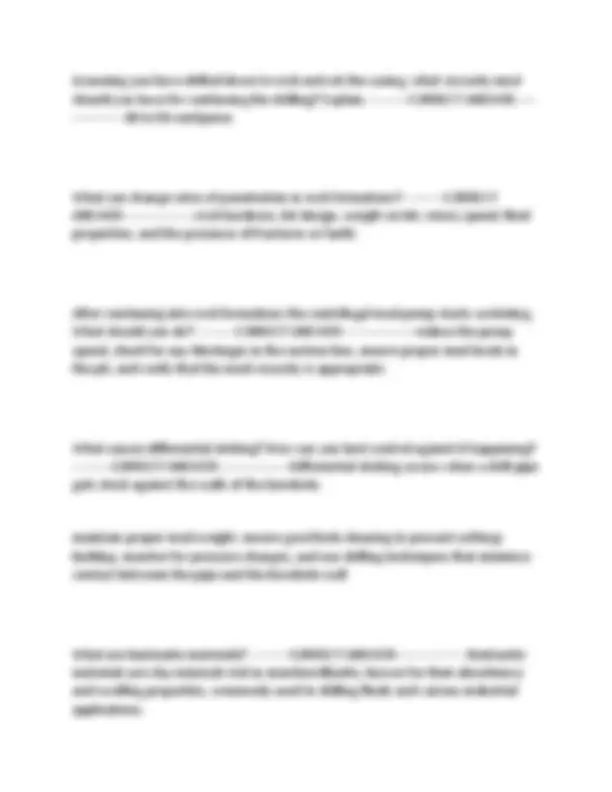
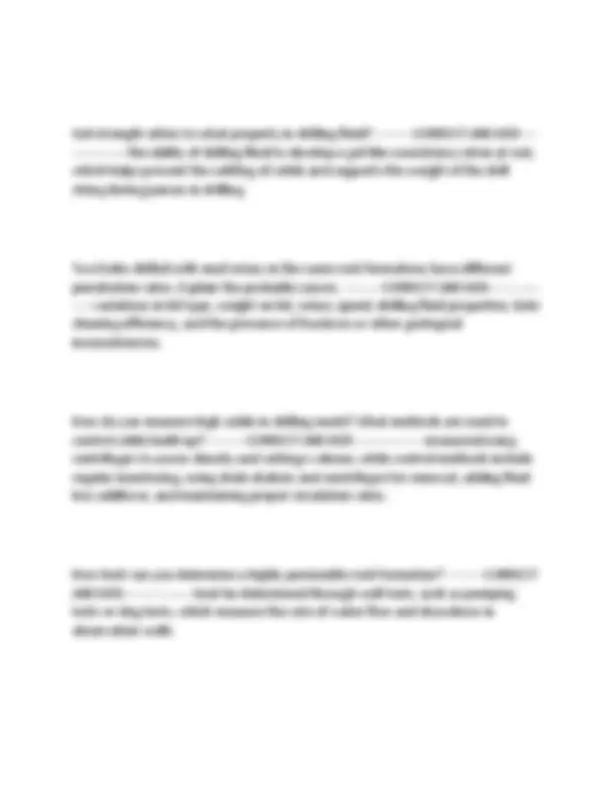
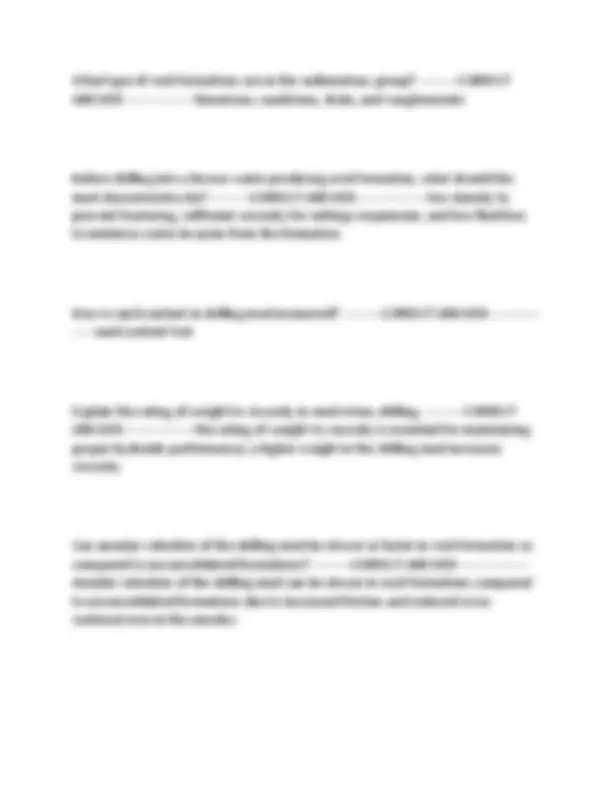
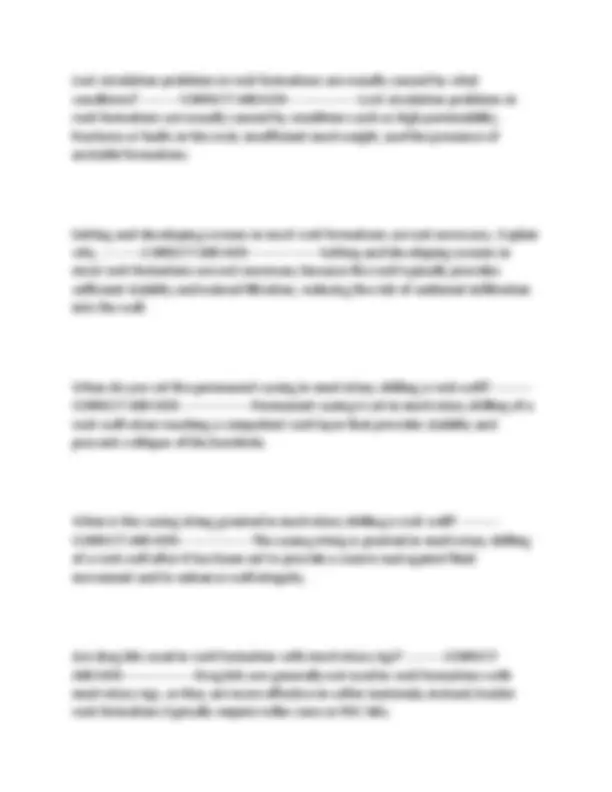
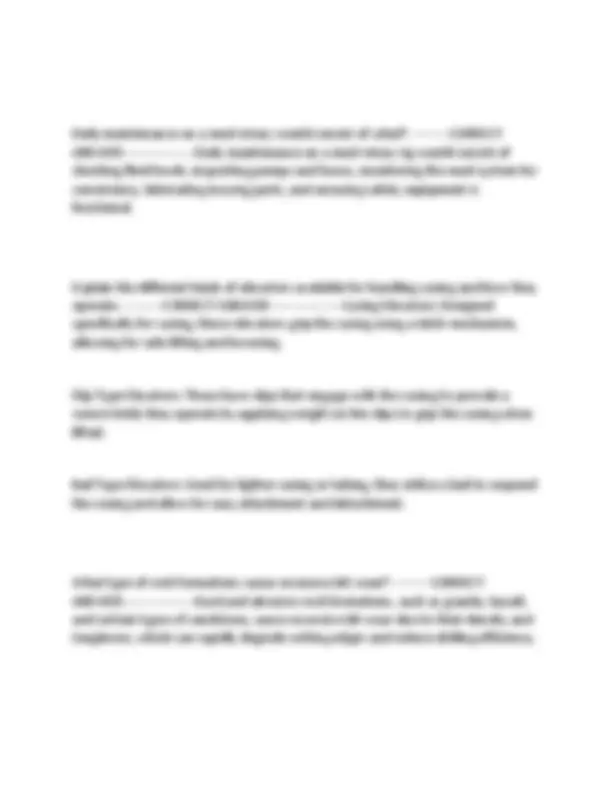
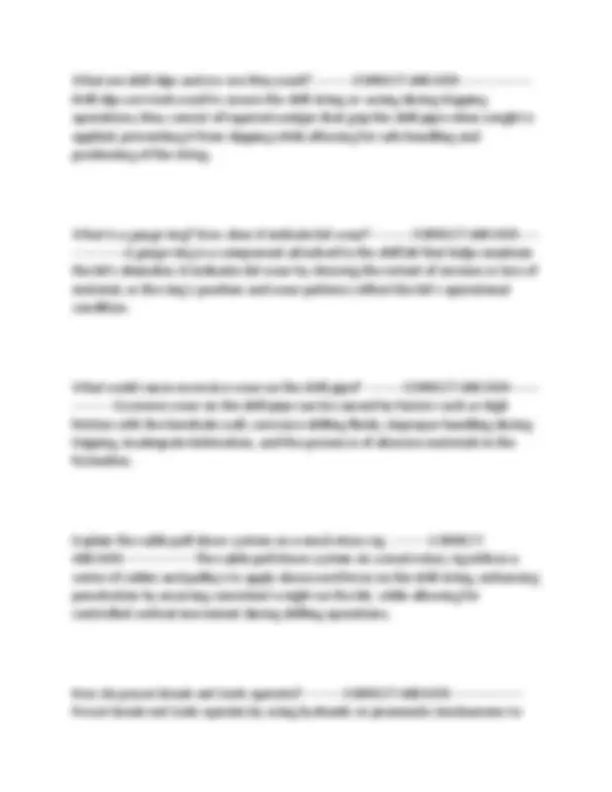
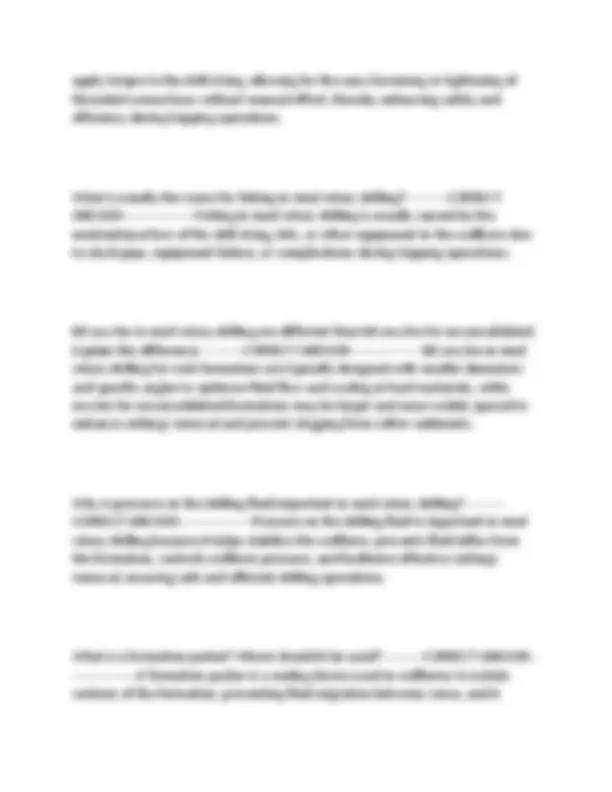
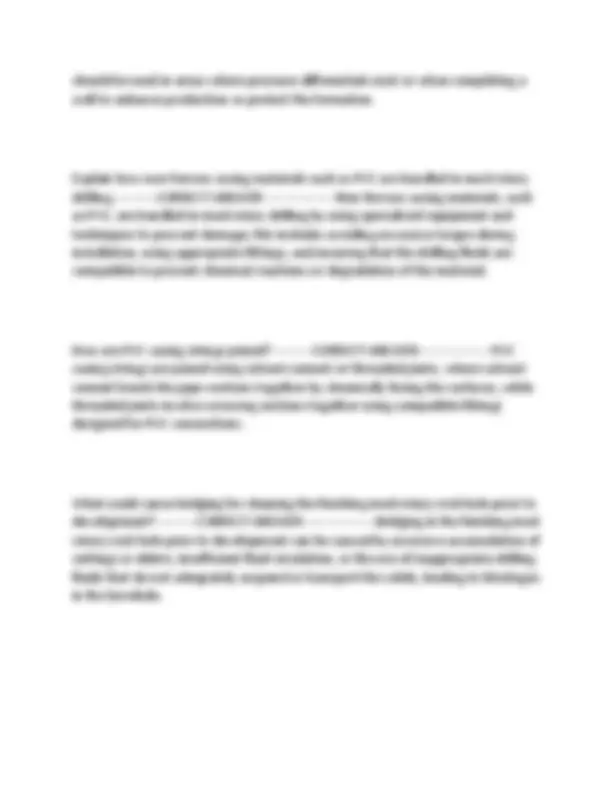


Study with the several resources on Docsity

Earn points by helping other students or get them with a premium plan


Prepare for your exams
Study with the several resources on Docsity

Earn points to download
Earn points by helping other students or get them with a premium plan
Community
Ask the community for help and clear up your study doubts
Discover the best universities in your country according to Docsity users
Free resources
Download our free guides on studying techniques, anxiety management strategies, and thesis advice from Docsity tutors
NGWA (National Ground Water Association) Air Rotary Drilling Exam | Featuring Principles of Air Rotary Drilling, Equipment Operation, Borehole Stability, and Air Pressure | Just Released
Typology: Exams
1 / 29

This page cannot be seen from the preview
Don't miss anything!






















In using mud rotary in unconsolidated formations, what is the relationship of speed in RPMs and feeds? ---------CORRECT ANSWER-----------------In mud rotary drilling for unconsolidated formations, higher RPMs require lower feeds to avoid collapsing the borehole, while lower RPMs can tolerate higher feeds for better penetration. What materials could be used to properly grout a mud rotary well? --------- CORRECT ANSWER-----------------Bentonite, cement, or a bentonite-cement mix. How does weight (density) of the drilling fluid affect the down hole conditions during drilling? ---------CORRECT ANSWER-----------------controls downhole pressure, stabilizes the borehole, prevents formation collapse, and helps control fluid loss or blowouts. How is mud weight controlled? What factors enter into the viscosity of mud? ------ ---CORRECT ANSWER-----------------Mud weight is controlled by adding materials like barite or bentonite Viscosity factors: Type of additives, fluid composition, and solids content.
What causes cavitations in pumping drilling method? ---------CORRECT ANSWER---- -------------Cavitation is caused by low fluid levels, high pump speed, air entrainment, or improper pump suction, leading to vapor bubbles that collapse and damage equipment. Explain why soft formations require low annular velocities. ---------CORRECT ANSWER-----------------to prevent erosion, collapse, or destabilization of the borehole due to excessive cuttings removal or formation washout. What can cause lost circulation in mud rotary drilling? ---------CORRECT ANSWER--- --------------Fractured formations, porous zones, or over-pressurized drilling fluids forcing fluid into the formation. What are the most common types of mud pumps? ---------CORRECT ANSWER------- ----------Duplex, triplex, and centrifugal pumps. Polyphosphates are used for what purpose? ---------CORRECT ANSWER----------------
Explain the difference between natural and artificial gravel packed wells. --------- CORRECT ANSWER-----------------Natural gravel pack: Utilizes the existing formation materials for filtration around the well screen. Artificial gravel pack: Involves adding specially selected gravel around the well screen to enhance filtration and stability. What information can be obtained from electric logging the well? ---------CORRECT ANSWER-----------------Electric logging provides information on formation resistivity, porosity, water quality, and the location of water-bearing zones. Why is it important to identify the boundaries of an aquifer? ---------CORRECT ANSWER-----------------is important to estimate water supply, manage sustainable extraction, and prevent over-pumping or contamination from adjacent formations. What techniques are used to obtain good samples in mud rotary drilling in unconsolidated formations? ---------CORRECT ANSWER-----------------Split-spoon sampling, core sampling, and continuous cuttings collection. What are hydrating clays? How does a mud rotary driller handle these formations? ---------CORRECT ANSWER-----------------Hydrating clays swell when exposed to water, causing drilling challenges.
To handle these, a mud rotary driller uses additives like polymers to inhibit swelling and adjusts mud properties to reduce sticking. In mud rotary drilling what are some indications that you have encountered a permeable formation? ---------CORRECT ANSWER-----------------Increased fluid loss, reduced mud returns, and faster drilling rates. Explain bit design for different unconsolidated formations. ---------CORRECT ANSWER-----------------Soft: Drag or modified PDC bits. Loose: Tricone bits, wide gauge. Clayey: Sharp-toothed bits, lower weight. Fractured: Reinforced bits, tricone/PDC combo. Mixed: Adjustable/hybrid bits. Where should you use drag bits? What formations are best to use the roller cone type bits? ---------CORRECT ANSWER-----------------Drag Bits: Use in soft formations (e.g., clay, silt). Roller Cone Bits: Best for loose, gravelly, and mixed formations.
Why is information concerning the geology important in proper grouting of unconsolidated formations? ---------CORRECT ANSWER-----------------Permeability of the Formation Stability of the Formation Formation Pressure Groundwater Flow Formation Composition. When would you gravel pack a well? ---------CORRECT ANSWER-----------------When the formation is unconsolidated, to prevent sand or fine material from entering the well, and to enhance water flow by stabilizing the borehole What formations are best to use a soft tri-cone bit? ---------CORRECT ANSWER------ -----------clay, sand, or shale. What functions must a drill pipe perform to drill unconsolidated formations? ------ ---CORRECT ANSWER-----------------Transmit torque circulate drilling fluid/air support drill string weight maintain borehole integrity
When would you use heavy drill collars? ---------CORRECT ANSWER-----------------to add weight on the bit, stabilize the drill string, and prevent buckling in deep or hard formations. Explain how chip catchers can aid in formation logging? ---------CORRECT ANSWER- ----------------help collect cuttings for accurate formation logging by preventing loss of samples during drilling, ensuring representative data. How does bit design vary with geology? ---------CORRECT ANSWER----------------- varies by formation hardness, with softer formations needing wider teeth and harder formations requiring tougher, more durable materials. Heavy steel casing would best be used in what rotary process? ---------CORRECT ANSWER-----------------best used in the air rotary process for stabilizing unconsolidated or collapsing formations. What air compressor checks must be made daily? ---------CORRECT ANSWER-------- ---------Oil level filters belts air pressure leaks
What methods are used to clean the hole of cuttings in air rotary drilling in unconsolidated formations? ---------CORRECT ANSWER-----------------Airflow, foam injection, and polymer use. How does air pressure change as the hole deepens? ---------CORRECT ANSWER----- ------------must increase as the hole deepens to maintain effective cuttings removal. What are the advantages and disadvantages of high pressure air rotary drilling in unconsolidated formations? ---------CORRECT ANSWER-----------------Advantages: Faster drilling, efficient cuttings removal. Disadvantages: Risk of formation collapse, loss of circulation, potential for blowouts. How does cost per foot air rotary compare with mud rotary in unconsolidated formations? ---------CORRECT ANSWER-----------------air rotary is generally lower due to faster drilling, but mud rotary may be more efficient in maintaining borehole stability in unconsolidated formations. Uphole annular velocity for most air rotary drilling would be? ---------CORRECT ANSWER-----------------3,000 to 5,000 feet per minute.
What methods are used to set screens in air rotary drilling? ---------CORRECT ANSWER-----------------Gravity placement, tremie pipe, and surge block. How do you develop wells that are air rotary drilled? - --------CORRECT ANSWER---- -------------Air surging, backwashing, and pumping. How can you control caving problems with air rotary drilling? ---------CORRECT ANSWER-----------------Use foam or polymers, reduce air pressure, and advance casing. What fluids are used in air rotary drilling in unconsolidated formations? --------- CORRECT ANSWER-----------------Water, foam, polymers. When is gravel packing usually necessary in air rotary wells? ---------CORRECT ANSWER-----------------to prevent sand intrusion. Mud rings can be controlled by what methods? ---------CORRECT ANSWER----------- ------Increase air pressure, use foam or polymers, and adjust drilling fluid properties.
Mist drilling is a name given to what technique in air rotary drilling? --------- CORRECT ANSWER-----------------a technique using a mix of air and small amounts of water or foam to cool the bit and lift cuttings How and when are grouting and/or cementing done in air rotary drilling? --------- CORRECT ANSWER-----------------after drilling, typically during well completion, to seal the annular space and prevent contamination. What happens when the bit starts balling in air rotary drilling? ---------CORRECT ANSWER-----------------occurs when sticky materials (like clay) accumulate on the bit, reducing cutting efficiency and slowing drilling. How does RPM vary in relation to the diameter of the hole in air rotary drilling? --- ------CORRECT ANSWER-----------------RPM decreases as hole diameter increases to maintain drilling efficiency and prevent excessive bit wear. Explain how down pressure may vary due to formation changes. ---------CORRECT ANSWER-----------------Down pressure increases in harder formations for better penetration and decreases in softer formations to avoid over drilling or hole collapse.
After a water bearing formation is located what is necessary to clean up the formation? ---------CORRECT ANSWER-----------------Air surging, backwashing, and pumping to remove fines and improve water flow. After the bore hole has been cased to the rock formation, how can drilling rates be increased using air rotary? ---------CORRECT ANSWER-----------------Increase drilling rates by using a smaller bit, higher air pressure, and optimizing down pressure in the rock formation. What are some advantages and disadvantages of down hole hammer drilling? ----- ----CORRECT ANSWER-----------------Advantages: Fast penetration, effective in hard rock, minimal cuttings clogging. Disadvantages: High air requirements, noise, wear on equipment in abrasive formations. What methods are used to speed up hole cleaning with air rotary? --------- CORRECT ANSWER-----------------Increase air pressure, use foam or polymers, and adjust up hole velocity. What affect does injecting water into the air stream cause in rock formations? ---- -----CORRECT ANSWER-----------------cools the bit, reduces dust, and helps remove cuttings in rock formations.
Compare speed/feed relationships in hard rock drilling using roller cone bits. ------- --CORRECT ANSWER-----------------Low RPM requires higher down pressure (feed) for effective penetration. Higher RPM with too much feed can cause bit wear or failure, while too little feed can reduce drilling efficiency. Fracture zones can cause crooked holes. What are some indications that fracture zones are encountered? ---------CORRECT ANSWER-----------------Sudden changes in penetration rate, loss of air pressure, hole deviation, or sudden drop in drill string weight The size of cuttings are indications that the bit is operating properly. Explain this statement. ---------CORRECT ANSWER-----------------larger, uniform cuttings indicate efficient drilling, while small or powdery cuttings suggest bit wear or improper function. How do roller cone bits differ for different formations? ---------CORRECT ANSWER- ----------------Soft formations: Larger, wider teeth for faster cutting. Hard formations: Smaller, tougher teeth with more durability.
After cutting several hundred feet of hard rock the rate has slowed down. What is the probably cause? ---------CORRECT ANSWER-----------------Bit wear or dulling, reducing cutting efficiency. What purpose does a Kelly saver sub serve? ---------CORRECT ANSWER----------------
Table drive: Advantages: Simpler, lower cost. Disadvantages: Less control, higher drill string wear. Why is it important to keep the bit in gauge? ---------CORRECT ANSWER--------------- --ensures proper hole diameter, prevents well collapse, and maintains drilling efficiency. How is the DHH drill bit sharpened? ---------CORRECT ANSWER-----------------by grinding the worn or rounded edges of the bit's cutting surfaces, usually with specialized grinding tools. How could a crooked hole be corrected using air rotary? ---------CORRECT ANSWER-----------------using stabilizers, reducing weight on the bit, and adjusting the drilling angle. Explain various methods for setting casing using air rotary equipment. --------- CORRECT ANSWER-----------------Driving: Use a hammer or rig to drive the casing down. Rotating: Rotate the casing into place using the drill rig. Pushing: Use the rig's hydraulic system to push the casing down.
What could cause lost circulation in air rotary drilling? ---------CORRECT ANSWER--- --------------Fractured formations, porous zones, or high-pressure air forcing fluids into surrounding formations. How are air rotary rigs sized? ---------CORRECT ANSWER-----------------air compressor capacity (CFM/PSI) drilling depth capacity mast height. If up hole velocities decrease, what could be the probable cause? ---------CORRECT ANSWER-----------------Reduced air pressure blockage in the air stream increased hole diameter. What can be added to water to aid in drilling with mud rotary? ---------CORRECT ANSWER-----------------Bentonite, polymers, and surfactants to improve viscosity, stabilization, and cuttings removal. What are some advantages of drill collars in unconsolidated formations? --------- CORRECT ANSWER-----------------Weight: Provides added weight for better penetration.